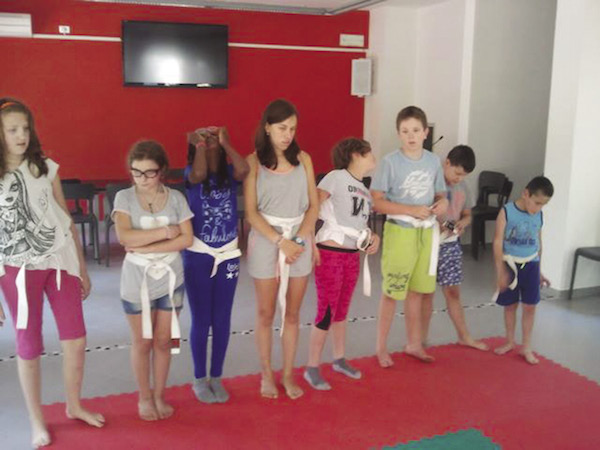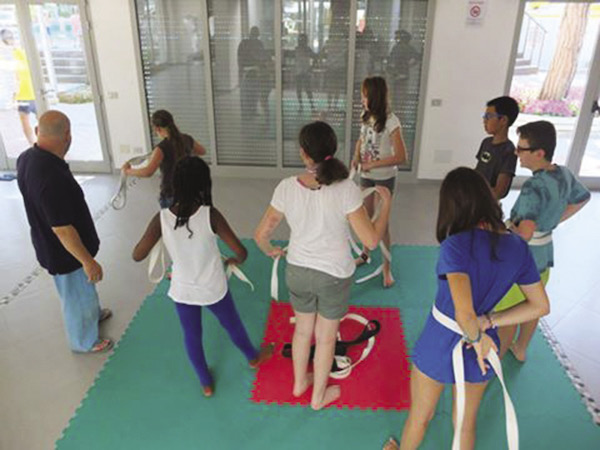At the beginning of the summer, I was lucky enough to participate in the summer study and rehabilitative holiday programme “A blast from the sun” organized by the Istituto Francesco Cavazza of Bologna for girls and boys living with vision loss. The first two days were spent learning and understanding the indoor and outdoor environment, making representations of that and managing it. Using the I.Ri.Fo.R. methodology for orientation and mobility, we moved in small groups inside the holiday village. To reach the beach, the restaurant, the swimming pool and other places of interest, some kids used their residual vision, others their long white cane while others had a sighted companion. We also spent two days completely dedicated to judo, and it is precisely about this experience that I would like to share.
It has been known that judo’s techniques can be successfully practised by blind and visually impaired people. In stand-up and ground fighting there is always a contact with the opponent so it is quite possible to practise this discipline without taking into consideration the visual factor. And this is not the only reason. The very birth of the Kodokan judo method, created by young university professor of pedagogy, Master Jigoro Kano, is linked to an educational goal. In fact, in 1882 he moved into the temple of Eisho where he organized a small room of twelve tatamis, putting in place an actual educational method. So he was not a ninja, nor a samurai, but an educator who had the ambitious goal of intellectual, moral and ethical growth through physical activity for people and society as a whole.

The two main rules which underlie judo: “maximum efficiency with minimum effort” and “prosperity and mutual well-being”. This sums up the entire method.
The first is done both in combat training with an opponent or with peers within the group at the gym. The second rule integrates, complete and in harmony, the first one through a seemingly very simple principle: “If I grow, you grow as well and, among friends and in combat, a change of perspective begins to take place. The more my opponent will be good, the more I will have to be good. This means that my opponent is actually a friend of mine and that motivates me to improve.”
And this is something that the kids were able to experience during the lessons which were held over the two days focused on judo. What I really liked was the use of some nuances that have enabled a consensus involving all judokas. In fact, we first made it clear that everyone who practises judo is a judoka, the Master and the students as well. Each one received a belt, a different colour based on experience and responsibility. For some small size judokas, the white belts I had brought were so long they could go around their bodies a couple of times.
Judo is practised on a mat called tatami, a soft and at the same time rigid support that allows stability and smooth falls. I had brought in my car for the occasion nine pieces of one-square metre each, in two colours, green and red, which could all fit together. Each kid took a mat. They explored it, tried to see how their body fit in that space, measured the perimeter, estimated how many feet or steps there were on the sides of the mat and the various differences between linear and square metre. Then we beat it with the hands, then with one foot, then both feet. We tried to enter the square metre of the other, defending our space. Then we did several other fun activities until we understood that if we wanted to do judo we should join the tatamis together. To do judo I need others, as is necessary to do anything. At that point, we built our own tatami.
Lessons were conducted with pleasure and enjoyment by all and, of course, in Japanese. The terms relating to the greetings that take place at the beginning and at the end of each move have gradually made sense and been appropriately used. The girls and boys found this activity really interesting because they managed to channel their energy and adopt a behaviour necessary for victory.
They learned the basics to fight on the ground among themselves and standing up with the Master and, fortunately, one at a time! Essential to the success of the initiative was Master Sanzio Magnani of the Judo Club Sakura Forlì who lent us the now “famous 9 m2 of tatami”. I want to thank him on behalf of all judokas.





.png)